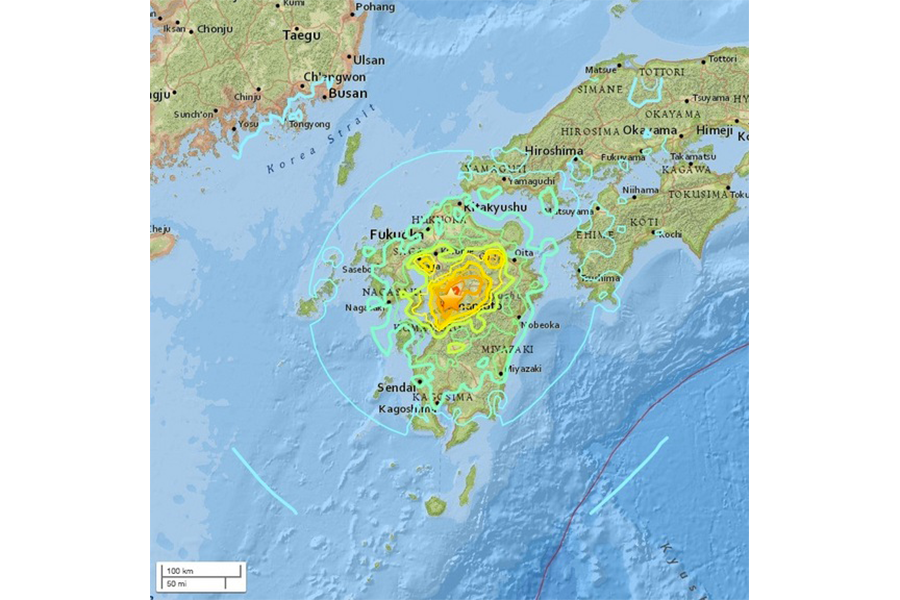Why do so many earthquakes strike Japan?
Loading...
A magnitude-7.0 earthquake struck southern Japan today, less than two days after a 6.2-magnitude temblor rocked the same region, triggering tsunami advisories in the area.
The most recent earthquake struck the Kumamoto region on Japan's Kyushu Island early Saturday (April 16) at 1:25 a.m. local time (12:25 p.m. ET on April 15), according to the U.S. Geological Survey (USGS). The smaller 6.2-magnitude quake on Thursday (April 14) killed nine people and injured hundreds more, reported CBS News.
With residents of the Kumamoto region reeling from two sizable earthquakes in as many days, and with memories of the massive 9.0-magnitude earthquake and tsunami that devastated Tohoku, Japan, in 2011 not far from people's minds, what is it about this part of the world that makes it so seismically active? [The 10 Biggest Earthquakes in History]
For starters, Japan is located along the so-called Pacific Ring of Fire, which is the most active earthquake belt in the world. This "ring" is actually an imaginary horseshoe-shaped zone that follows the rim of the Pacific Ocean, where many of the world's earthquakes and volcanic eruptions occur.
Within the Ring of Fire, several tectonic plates — including the Pacific Plate beneath the Pacific Ocean and the Philippine Sea Plate — mash and collide.
"The Earth's surface is broken up into about a dozen or so major chunks that are all moving around. Where they all interact at their edges, interesting things happen," said Douglas Given, a geophysicist with the USGS in Pasadena, California.
Today's earthquake seems to have been caused by the Philippines Sea Plate diving underneath the Eurasia Plate, according to Paul Caruso, a geophysicist with the USGS.
While Japan is no stranger to earthquakes, the 7.0-magnitude temblor is one of the largest ever recorded in this part of southern Japan, Caruso told Live Science.
"The second-largest was probably on March 20, 1939 — there was a magnitude-6.7 in this area. And we've had magnitude-6.5 and magnitude-6.3 earthquakes, but this is the largest quake that has been measured in that vicinity," he said.
A tsunami advisory was issued after today's earthquake, but it was subsequently lifted by the Japan Meteorological Agency, and there are currently no major tsunami warnings or advisories in effect.
Not all earthquakes trigger tsunamis, Caruso said. In general, there are three key ingredients that can produce a dangerous earthquake-tsunami combination, he added. First, the earthquake must be at least a magnitude-7 temblor. Second, the quake's epicenter has to be underneath the ocean, Caruso said. And finally, the earthquake has to be shallow.
"We have quakes around Fiji all the time, but those are sometimes 400 miles [640 kilometers] underground, so they aren't going to generate a tsunami," he said.
Today's earthquake was shallow — about 6 miles (10 km) underground — but the epicenter was on land, meaning there aren't likely to be any dangerous tsunamis as a result, Caruso said.
Given said he hasn't seen many damage reports yet, but Japanese authorities and scientists at the USGS will be monitoring the area for potentially dangerous aftershocks, which are smaller quakes that follow the largest event in a series and that generally decrease in strength.
"This seems to be a pretty energetic sequence, and there are lots of large aftershocks," Given told Live Science. "And of course, after a large earthquake, structures are often weakened as a result. Additional damage can be expected."
Residents of the area should expect more shaking in the coming days, according to Caruso.
"We can say for certain that there are going to be more aftershocks in this area," he said. "Exactly when and how big they're going to be is difficult to say, though. No one can predict that."
Follow Denise Chow on Twitter @denisechow. Follow Live Science @livescience, Facebook & Google+. Original article on Live Science.
- Waves of Destruction: History's Biggest Tsunamis
- 7 Craziest Ways Japan's Earthquake Affected Earth
- Image Gallery: This Millennium's Destructive Earthquakes
Copyright 2016 LiveScience, a Purch company. All rights reserved. This material may not be published, broadcast, rewritten or redistributed.







